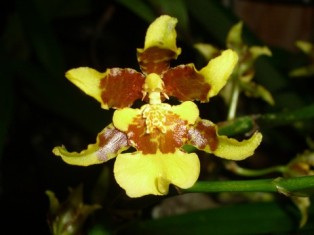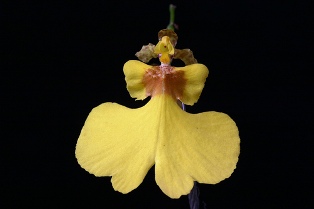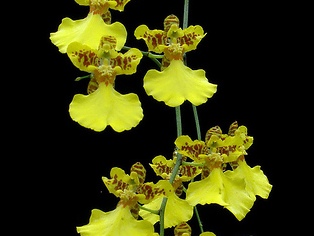┌−−−−−−−−−−−−−−−C. quadricolor (Colombia)
┌ −└ −−−−−−−−−−−−−−−−−L. rex (Colombia)
│ ┌−−−−−−−−−−−−−−−C. gaskelliana var. alba (Colombia, Venezuela)
┌│ │ ┌ C. trianei 'Junio' (Colombia)
│ └−│ ┌ −−−−−└C. trianei var. amesiana 'Floriana' (Colombia)
│ │┌−−− └ −−−−−C. trianaei 'Dan' (Colombia)
│ └│ ┌ C. labiata var. amoena 'Fowleiana' (Brazil)
┌│ │ ┌└ C. percivaliana 'Summit' (Venezuela)
││ └┌ └−−C. schroederae 'C. Arango' x 'G. Misa's' (Colombia)
┌││ └ −−−−−−−−−−C. warneri (Brazil)
┌││└ −−−−− −−−−−C. mossiae (var. semialba x var. semialba 'Idem') (Venezuela)
││└ −−−−− −−−−− −−−−− C. jenmanii var. alba 'Fuchs Snow'(Venezuela)
││ ┌ −−−−−C. aurea 'Scully'sTipperary' (Colombia)
┌││ ┌ └−−−−−┌ C. warcewiczii var. semialba (Colombia, Brazil)
│ └ │ └ C. warcewiczii var. alba 'Leo Holgium' (Colombia, Brazil)
┌│ └−−−−− C. warcewiczii ('Low's x 'Sanderiana) (Colombia, Brazil)
│ │ (Stellata亜属)、花径小さい、側花弁幅狭い、唇弁特異
│ └−−−−−┌ C. luteora (Brazil, Peru, Equador, Bolivia)
┌│ └ C. iricolor
││ Rhizanthemum亜属、花を葉の退化したシュートに付ける、二枚葉
│ └ −−−−− −−−−−┌ C. walkeriana var Coerulea 'Azul Perfecta' (Brazil)
┌│ └ C. nobilior var. coerulea (Brazil)
││ C. kerrii、1-2茎、茎は細い、
│ └ −−−−− −−−−− −−−−−C. kerrii (Brazil)
│ Diphyllae亜属、シースは葉身を持たない、二枚葉、Intermedia節
│ ┌ C. intermedia var. aquinii 'Boa Vista' (Brazil)
┌−│ ┌ └ C. harrisoniana 'Shonan' (Brazil)
│ │ ┌ −└−−−−− C. forbesii var. alba (Brazil)
│ │ │Guttata節
│ │ ┌ −│ ┌ C. guttata 'Nakajima' (Brazil)
│ │ │ └−− −┌ −└ C. elongata (Brazil)
│ │ │ └−−┌ C. leopordii (Brazil)
│ │ │ └ C. amethystoglossa (Brazil)
│ │ │Intermedia節
│ └− │ ┌ −−−−− C. loddigesii (Brazil, Argentina)
−│ │ ┌ −−−−−└ −−−−−C. x dolosa var. alba (= C. loddigesii × C. walkeriana) (Brazil)
│ │ │ Acranthemum節
│ └ −│ ┌ C. aclandiae (Brazil)
│ │┌ −−−−−└ C. bicolor (Brazil)
│ └ │ Guttata節
│ └ −−−┌ −−−−−C. porphyroglossa (Brazil)
│ └ −−−−−┌ C. schilleriana 'Sanderiana' (Brazil)
│ └ C. violacea (Guyana-Peru, Venezuela,Brazil, Equador)
│ Skinneri亜属、多輪 Skinnneri節、中米、二枚葉、dowiana
│ ┌ C. skinneri 'Brumen Insel' (Guatemala - Panama)
└−−−−−−−−−−┌ −−−−− └C. x guatemalensis (skinneri x aurantiaca?) (Guatemala)
│ Aurantiaca節、
└−−−−−┌ −−−−− C. aurantiaca 'Marigold' (Mexico, Guatemara, El Salvador, Honduras)
└−−−−┌ C. bowringiana var coerulea (Guatemara, Belize)
└ C. decker 'Brecht' (Guatemala - Panama, Colombia, Venezuela, Trinidad)
カトレヤ近縁属の遺伝子系統解析
┌−−−−−−−−−−−−−−−C. maxima Cattleya (4) Equador, Colombia, Peru
┌−−−│ ┌ C. bowringiana (Skinneri/Skinneri) Guatemala Belize
│ │ ┌ −−−−−└C. skinneri (Skinneri/Skinneri) Central America
┌−−│ └┌−−− └ −−−−−C. aurantiaca (Skinneri/Aurantiaca) Guatemala, Belize
│ │ └−−−−− C. walkeriana (Rhizanthemum) Brazil
│ └−−−−− Epidendruam secundum (4) Peru, Bolivia, Colombia, Equador, Venezuela
┌−−│ ┌−− Laelia anceps (Laelia 8) Mexico
│ │ ┌ └┌ Laelia dayana (Brasilienses 8) Brazil
│ │ ┌−−−│ └−− Laelia purpurata (Brasilienses 8) Brazil
┌−│ └−−−│ └−−−Sophronitis coccinea (8) Eastern Brazil
│ │ └−−−−−┌ −−−−−Brassavola cuculatus (8)Mexico-Honduras-南米北部
−│ │ └−−−−−Rhyncholaelia digbyana (8) Mexico, Hondurus
│ └−−−−−┌ −−−−−Sophronitella violacea (8) Eastern Brazil
│ └−−−−− Leptotes bicolor (6) Eastern Brazil
└ −−−−−−−−−−−−−−−Encyclia cordigers (4) Mexico, Central America, Colombia, Venezuel
4や8は花粉塊の数です。
各種の特徴と性質
(カトレヤ原種西東京発さんのHPから転載させていただきました)
植生と温度の項などは、「原種カトレヤ図鑑http://orchidenc.fc2web.com/Cattleya.htm」から抜粋して転載させていただきました。
| 植生 | 温度 | |||||||||
|
1 aclandiae アクランデー 、。 (開花2月〜3月ころ) 二葉 | ブラジル | 標高100-400m海岸近くの海風に吹かれる少雨の乾燥地帯に生える矮性着生種 | 花弁中輪で点花、リップはピンク、セルレヤ、ペタル、セパルは黄色に茶の斑点。 | 草丈は小さく、 | 栽培は二葉のうちでは難しい。 | 中高温性 | 水と風通を好む。 | 、(開花4月〜6月ころ) | 二葉 | |
| 2 amethistoglossa アメシストグロッサ | ブラジル | 花弁中輪で点花・セルレア、ペタル、セパルは薄いピンクに濃紫紅色の斑点 | 、草丈は大きくバルブは細長い | 栽培は二葉のうちでは特に水の管理が難しい | 水の管理 | (開花2月〜3月ころ) | ||||
| 6 bicolor ビカラー ブラジル 二葉 | 花弁中輪で緑花から茶花に変化、多花。 | 草丈は大きくなり | 栽培は二葉のうちでは易しい。 | 低中温性 | (開花8月〜10月ころ) | |||||
|
15 xdolosa ドロサ ブラジル loddigesii x walkerianaの自然交雑種。 | 花弁中輪でアルバ・セルレア、 | 草丈は小さい、 | 栽培は二葉のうちでは易しい。 | 風通を好む。 | 冬〜春咲きの強健種。 | |||||
|
20 x elongata エロンガタ ブラジル C.guttata×L・purpurata 自然交雑種 二葉 | 日当たりの良い岩に生える | 花弁中輪で茶花から緑花に変化、 | 草丈は大きい、葉が丸弁や細長厚形など |
栽培は二葉のうちでは難しい。 | 生長期に日照は強めに。 | (開花8月〜3月ころ) | ||||
|
21 forbesii フォーベシー ブラジル | 標高200mまでの流れや海岸に近い樹木または岩、樹下の藪に生える低中温性の着生、岩生蘭 | 花弁小輪で緑花から黄花に変化、 | 草丈は小さい | 栽培は二葉のうちでは易しい。 | 低中温性 | 乾かし気味に。 | (開花 4月〜6月ころ) | |||
|
27 guttata グッタタ ブラジル | 海岸に近い場所にみられる低中温性着生・岩生種 | 花弁中輪で茶花から緑花に変化、 | 草丈は大きくなり | 栽培は二葉のうちでは難しい。 |
休眠期は乾かしぎみ。 開花のために冬に乾燥休眠 | (開花7月〜9月ころ) | ||||
| 28 harrisoniana ハリソニアナ ブラジル 花弁中輪でチポ・アルバ・プンクタータ、草丈は普通で栽培は二葉のうちでは難しい。生長期に水と肥料。 (開花7月〜9月ころ) | 沼の多い地域の藪に生える | 中温性 | ||||||||
| 31 intermedia インターメディア ブラジル | ブラジルのリオデジャネイロ近郊、パラグアイ、ウルグアイ、ペルーの海や流れにちかい岩や低木に生える | 花弁中輪でチポ・アルバ・アッキニー・セルレア・ベノサ、 | 草丈は普通でバルブは細く | 栽培は二葉のうちでは易しい。 | 中温性 | 乾かし気味。 良く日に当てた方が良い。 | (開花2月〜3月ころ) | |||
|
40 tigrina レオポルディイ(leopodii)が ティグリナ(tigrina) leopoldii は異名(シノニム) ブラジル 。 | 花弁中輪点花で茶花から緑花に変化、ピンク、花は株に比べて小さな花を多数咲かせる。 |
草丈は大きくなり 大型種。 | 栽培は二葉のうちでは難しい | 生長期に肥料。 | (開花6月〜10月ころ) | |||||
|
41 loddigesii ロディゲシー ブラジル | 着生・岩生種 | 花弁中輪でチポ・アルバ・プンクタータ・カリーナ、 | 草丈は普通でバルブは細く | 栽培は二葉のうちでは易しい。 | 中温性 |
風通を好 む。 | (開花11月〜1月ころ) | |||
|
60 x porphyroglossa パピログロッサ ブラジル 花弁小輪で黄緑、レンガ色で多花性、春に芳香のある花をつける。着生種で、水辺の低木に見られる。成長期に肥料を十分に。 (開花5月〜7月ころ) C.bicolor×C.granulosa 自然交雑種 | 水辺の低木に見られる | バルブは短茎・棒状で中型。 | 二葉のうちでは難しい。 | 中高温性 | ||||||
| 64 schilleriana シレリアナ ブラジル 花弁は中輪で濃褐色の斑点、紫系、通風を好む。香り強い、希少種。 (開花5月〜9月ころ) | 木や崖に生える | 草丈は小きい、 | 栽培は二葉のうちでは難しい。 | 中高温性 | 平鉢植えが良い。 | |||||
| 78 violacea ヴィオラセア ブラジル・ボリビア・エクアドル・コロンビア・ベネズエラ 花弁中輪でチポ、アルバ、セミアルバ、セルレア、化、乾かし気味に。 (開花5月〜8月ころ) | 標高200-700m付近の高温多湿熱帯雨林の川のそばの日当たりの良い木に着生 | 8cmの花茎に3-7花を晩春から初夏につける。花径13 cm 。 | 草丈は小さい | 栽培は二葉のうちではやや難しい。 |
高温性 冬18-20℃以上 | この種は休眠期がない | ||||
黄花オンシジウムの系統 2014.8.2 OrchidRoots
Onc. Gower Ramsey = Onc. Goldiana x Onc. Guinea Gold, 1977
Onc. Guinea Gold (sphacelatum × varicosum
Onc Goldiana = Onc flexuosum X Onc sphacelatum 1940
ゴワーラムゼイは一代交配種同士の交配、O. sphacelatumが50%
Onc. Aloha Iwanaga = Onc. Goldiana x Onc. Star Wars, M.Sato 1990
Onc Star Wars = Onc. Varimyre X Onc. Nonamyre 1977
アロハイワナガは片親がゴワーラムゼイと同じ
Gom. varicosa 33.98%, Onc. sphacelatum 25.0%, Gom. flexuosa 25.0%, Gom. forbesii 7.42%, Gom. imperatoris-maximiliani 6.25%, Gom. marshalliana 2.34%
Onc. Varimyre E.Iwanaga 1963 (registered RHS) ( Gomesa Sultamyre × Gomesa varicosa )
Gomesa Sultamyre Vach.& Lec. 1959 (registered RHS) = ( Gomesa Sultane × Gomesa Palmyre )
Gomesa Sultane V. 1943 (registered RHS) ( Gomesa Boissiense × Gomesa Farandole )
Gomesa Boissiense V. 1924 (registered RHS) ( Gomesa forbesii × Gomesa varicosa )
Gomesa Farandole V. 1935 (registered RHS) ( Gomesa Comtesse de Bretonne × Gomesa Mantinii )
Gomesa Comtesse de Bretonne Mattan 1928 (registered RHS) ( Gomesa Boissiense × Gomesa varicosa )
Gomesa Palmyre V. 1951 (registered RHS) ( Gomesa Saladin × Gomesa varicosa )
Gomesa Saladin V. 1945 (registered RHS) ( Gomesa Comtesse de Bretonne × Gomesa Farandole )
Gomesa Nonamyre E.Iwanaga 1964 (registered RHS) ( Gomesa Nona × Gomesa Sultamyre ) OrchidRoots
Gomsa Nona = Gom. imperatoris-maximiliani x Gom. varicosa 1938
Oncidesa Sweet Sugar M.Sato 1990 (registered RHS) ( Oncidesa Aloha Iwanaga × Gomesa varicosa )
スイートシュガーはアロハイワナガと原種の交配種です。varicosaが2/3
Gom. varicosa 67.02%, Onc. sphacelatum 12.5%, Gom. flexuosa 12.5%, Gom. forbesii 3.74%, Gom. imperatoris-maximiliani 3.13%, Gom. marshalliana 1.18%
Gomesa varicosa (Lindl.) M.W.Chase & N.H.Williams 2009 (accepted Kew)
Oncidium cheirophorum
is an epiphytic orchid from the genus Oncidium.
Contents[show]
DescriptionEdit
Plants blooms in the fall with many 1.5 cm wide flowers. Flowers are fragrant.
DistributionEdit
Plants are found in Nicaragua to Colombia at elevations of 1000 to 2500 meters
CultureEdit
Grow in cool to warm conditions with moderate to bright light. Water the plant right before the potting mix starts to dry. Plants should be potted in a well drain medium such as medium fir bark.
Oncidium flexuosum
Description
Plants blooms from fall to winter with up to ten 3 cm wide neon yellow flowers
Distribution
Plants are found in creeks and marshes in the montane forest of Brazil, Argentina, Uruguay and Paraguay at elevations of 500 to 800 meters
Culture
Grow in cool to warm conditions with moderate light. Water the plant right before the potting mix starts to dry. Plants should be potted in a well drain medium such as medium fir bark.
Oncidium ornithorhynchum
is an epiphytic orchid from the genus Oncidium.DescriptionEdit
Plants blooms in the winter with many 2 cm wide flowers. Flowers are fragrant.
DistributionEdit
Plants are found from Mexico to Colombia at elevations up to 1500 meters
CultureEdit
Grow in cool to warm conditions with moderate to bright light. Water the plant right before the potting mix starts to dry. Reduce watering during the winter. Plants should be potted in a well drain medium such as medium fir bark. Plant can be mounted
Oncidium sphacelatum
Description
Plants blooms in the spring with several 2.5 cm wide flowers. Flowers are fragrant.
Distribution
Plants are found in Mexico, Guatemala, Belize, El Salvador, Honduras, Nicaragua, Costa Rica and Venezuela at elevations below 1000 meters
Culture
Grow in intermediate to warm conditions with moderate to bright light. Water the plant right before the potting mix starts to dry. Plants should be potted in a well drain medium such as medium fir bark.
Oncidium varicosum
Description
Plants blooms from summer to fall with many 3.75 cm wide flowers.
Distribution
Plants are found in Brazil, Bolivia and Paraguay at elevations of 800 to 1100 meters
Culture
Grow in intermediate to warm conditions with moderate to bright light. Water the plant right before the potting mix starts to dry. Plants should be potted in a well drain medium such as medium fir bark.



Onc. sphacelatum, Onc. varicosum, Onc. flexuosum
オンシジウムの分類の変更について
素人園芸解説さんから転載させていただきました。
http://heboen3.g1.xrea.com/youran/onc.html
解説
オンシジウムの系統は、「薄葉系」「厚葉系」「剣葉系」「棒葉系」の四つに大別される。ここで取り上げているのは、切り花やギフト品でおなじみの「薄葉系」である。
最近行われたラン科植物の再分類によって、「厚葉系」「剣葉系」「棒葉系」の各種については、すでにオンシジウム属から別属に移されている。また、薄葉系も、主だった原種がゴメサ属やゼレンコア属などに移っていき、かつて大所帯だったオンシジウム属は、やや寂しくなってしまった。
薄葉系オンシジウムは、楕円型の扁平なバルブを持ち、しなやかな薄い葉を付ける。性質が丈夫で育てやすい。花色は黄色が多いが、淡紅色や、赤褐色の模様が入るものもある。
主な原種は、オーニソリンクム、オヌスツム、オブリザツム、ケイロフォルム、ソトアヌム、フォーベシーなど。交配種の「ケイロ・ククー」「スイート・シュガー」「トゥインクル」も人気。
上記の通り、オンシジウム属から、いくつかの原種がゴメサ属やゼレンコア属などに移っていった影響で、一部の交配種も、属名が変化している。例えば、かつてオンシジウムの人気品種だった「アロハ・イワナガ」「スイート・シュガー」などは、現在はオンシデサ属に属する。
薄葉系以外の系統(厚葉系・剣葉系・棒葉系)についても、簡単に触れておく。いずれも多肉質の葉を持ち、乾燥に強く、一貫して乾き気味に管理する。寒さには弱いので、越冬温度は最低10℃を保つ。
厚葉系…主な原種は、スプレンディダム、ナヌム、ハリソニアヌム、ランセアヌムなど。葉が厚く多肉質。現在はトリコセントルム属に属する。
また、かつて、この仲間に含まれていたクラメリアナ、パピリオ、ベルスティーギアナの三種は、現在はサイコプシス属に属する。これらは強い日光を嫌い、高い空中湿度を好む。耐寒性が弱く、冬は最低13℃を保つ。
剣葉系…主な原種は、バリエガツム、プシルム、プルケルムなど。葉が短い剣(または鎌)状。葉が幾重にも重なり、明確なバルブを持たない。空中湿度を好む。現在はトルムニア属に属する。
棒葉系…主な原種は、ジョネシアヌム、セボレタ(ロンギフォリウム)、ミクロキルムなど。葉が棒状。最も強光と乾燥を好む。現在はトリコセントルム属に属する。
注意点・病害虫
耐暑性はあるが、真夏は風通しのよい涼しい日陰で管理する。
種類によっては、毎年、新芽の位置が、少しずつ斜め上にせり上がる。放置すると、勝手に鉢から出て行ったり、鉢が不安定になったりする。そうなる前に植え替えるか、せり上がった部分だけを切り取って株分けする。
花茎が伸びている間に、小さなガの幼虫が、つぼみや花茎の先端部を食害し、開花しなくなることがある。つぼみや花茎の内部に入り込んでおり、見つけにくいので注意する。